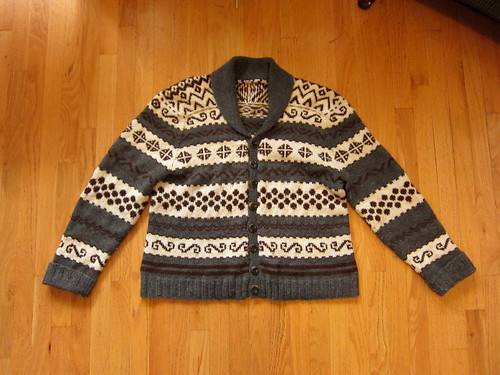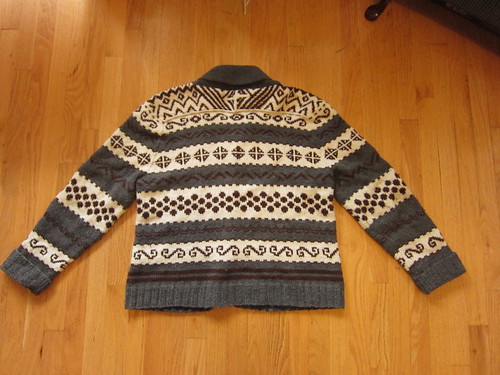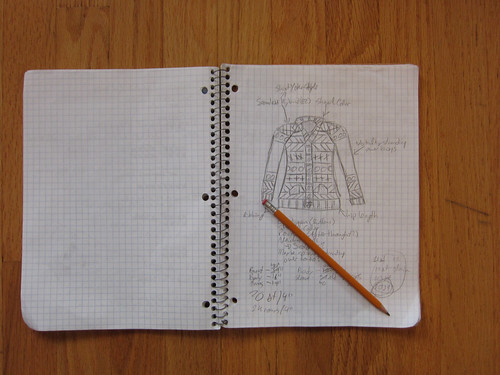I've been asked to share a bit of a story with all of you. Well, a story and a bit of a discussion. I'm going to share my personal design process with you. This is how I work, and maybe the insight will be useful or terrifying... My partner and I were sitting around the house one day when she turned to me and said "you know that sweater of yours?" To which I replied "No. Which sweater?" "Oh, that grey and brown knit one in the bottom drawer that you wear." "You mean the one that doesn't fit, is kind of ratty, and that I really only wear when I'm deathly ill with a fever?" "Yeah, that one. I want one." "You want a ratty, sick-day, ill-fitting knit sweater?" "No, I want a nice, hand made sweater that looks like that one." Well, that was the start of it. But by no means the end. Here's the sweater, front and back. It's based on an Elizabeth Zimmermann seamless sweater, into which I crammed a bunch of different stranded motifs.


Next, we got to planning the new sweater. We plunked down in front of computer and started trawling Ravelry. Honestly, it wasn't terribly productive. There were existing designs that had some elements that my partner liked, but really nothing close to what she had in mind. So we let it mull for a few days, and came back to it later. "So, what do you think you want your sweater to look like?" "I don't know! You're the knitter, I have no idea what will look good." D'oh! Design mistake 101. People hire designers (graphic, knitting, software, whatever) because we are supposed to be experts. If people know what they want, why go to a professional in the first place? This time, I sat down alone and thought about my original sweater and made a list of what were the strongest, most identifiable features. Let's be honest, I can sit down and pick out the tiniest, most intricate of details, but I bet that those were not what were appealing. I basically came up with this list:
- Worsted weight (Cascade 220)
- Dark grey, dark brown, cream fair isle in pretty broad, clear bands
- Shawl collar
- Shirt-yoke (across the back of the neck)
- Lovely handmade wooden buttons
- Seamless, classic, Zimmermann construction
- Worked FLAT. Not in the round. That means there is purl-side stranded colourwork... (this is more of a personal note, not so much a visible design feature)

Basically, a more refined version of my sweater:
- Stranded colourwork, in three neutral colours
- Shawl collar
- Not too heavy a weight of yarn
- Cardigan with buttons
- Ribbing and the hems and cuffs
- Hip-length
- Not excessive bulk over certain areas (upper arms, bust)
- Maybe pockets and elbow patches

Great post! Everything starts with a motivation, right? About the flat knitting. Don't you thing that steeking would be better? I never done that but I would definitely give it a try with a cardigan like this one! Looking forward to read following posts!
ReplyDeleteThanks so much! In many ways, yes, steeking would be far simpler (and I have steeked several different projects now). There are a few factors that outweigh it here: first I'm using a superwash wool, so a crocheted steek wouldn't be reliable (in my opinion), and I don't have access to a sewing machine for a sewn steek. Second, most of the sweater is being designed as I get around to it, including the upcoming shawl collar/v-neck opening - since I don't really know what shape that is going to be exactly, I want to be able to visualize it as I go. If I were to write this as a formal pattern, I would certainly do a steeked version based off this math.
Delete